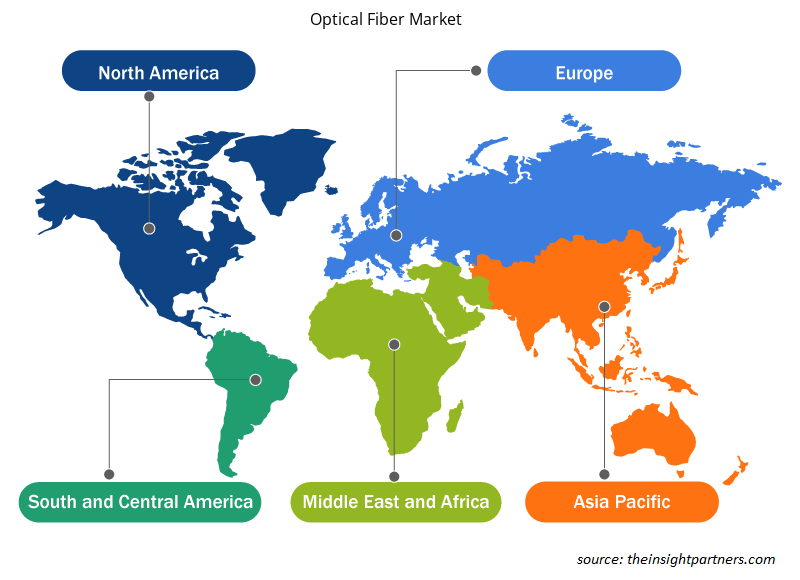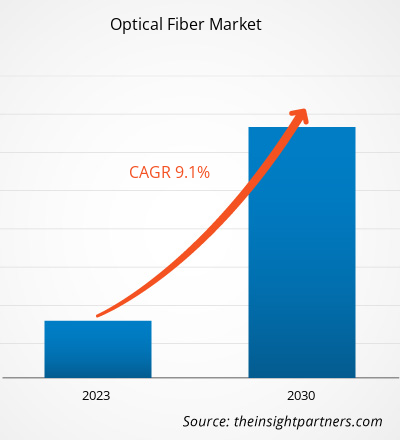光纤市场规模预计将从 2022 年的 93.2 亿美元增长到 2030 年的 187.6 亿美元;预计从 2022 年到 2030 年,光纤市场的复合年增长率将达到 9.1%。对高速互联网的需求不断增长和电信基础设施的发展预计将成为市场的主要趋势。
光纤市场分析
预计光纤网络的发展将受到消费者数据需求激增和物联网 (IoT) 设备快速普及的推动。此外,全球许多国家的政府都对光纤部署进行了大量投资,为市场增长创造了丰厚的机会。例如,美国需要在未来五到七年内大幅扩展光纤基础设施,以支持即将到来的 5G 无线网络,促进宽带竞争,并提供农村宽带覆盖。这需要在光纤电缆部署方面投资约 1300-1500 亿美元。这些发展凸显了电信行业企业利用不断增长的光纤基础设施需求和利用 5G 革命创造的机会的巨大潜力,进一步推动 光纤市场的 增长。
光纤市场行业概况
光纤,也称为光导纤维,是一种高度灵活的玻璃或塑料纤维,能够将光信号从一端传输到另一端。这些光纤在光纤通信中起着至关重要的作用,与传统电缆相比,它具有传输距离更长、带宽更高的优势。与金属线相比,光纤更受青睐,因为光纤信号损耗更低,且不受电磁干扰的影响,而电磁干扰是金属线面临的常见问题。除了电信之外,光纤还广泛用于照明、成像以及将光或图像传送到密闭空间等应用,类似于纤维镜的应用。此外,专用光纤用于各种用途,包括 光纤传感器 和光纤激光器。
定制此报告以满足您的需求
您可以免费定制任何报告,包括本报告的部分内容、国家级分析、Excel 数据包,以及为初创企业和大学提供优惠和折扣
- 获取此报告的关键市场趋势。这个免费样品将包括数据分析,从市场趋势到估计和预测。
光纤市场驱动因素和机遇
光纤到户 (FTTH) 连接的采用率提高,有利于市场增长
传统互联网技术无法与 FTTH 更快的速度和更可靠的连接相媲美。根据光纤宽带协会 (FBA) 的研究,2021 年美国使用光纤互联网的住宅数量超过 6000 万,比 2020 年的约 5400 万增长了 12%。此外,该研究还显示,43% 的美国家庭和 60% 的加拿大家庭已经可以使用光纤互联网。根据调查,Verizon、AT&T 和 Lumen 等大型市场参与者位列前五大有线电视管理服务组织 (MSO) 之列,约占所有光纤互联网连接的 72%。相比之下,Frontier、Windstream、TDS 和 Consolidated 等二级区域运营商占扩张的 10%。
不断发展的5G基础设施
预计向 5G 的过渡和相关的基础设施升级将在预测期内推动对光纤的需求。疫情导致了通信模式的转变,越来越多的人远程工作、上网课并通过数字平台传输信息。因此,预计光纤铺设服务将在全球范围内得到巨大发展。这将使5G 技术得到更快的实施,这将使人们受益匪浅,因为他们可以获得更快的连接,从而促进发展和进步。因此,预计在预测期内,不断增长的 5G 基础设施将推动对光纤的需求。
光纤市场报告细分分析
有助于得出光纤市场分析的关键部分是按类型、模式、组成和最终用户划分的覆盖范围。
- 根据类型,光纤市场细分为阶跃型光纤和渐变型光纤。渐变型光纤部分在 2022 年占据了更大的光纤市场份额,预计在预测期内将在市场上录得更高的复合年增长率。渐变型光纤在纤芯中具有不同的折射率,该折射率从纤芯中心向外移动时会减小。光在穿过介质时,在弯曲路径中在边缘的传播速度比在中心的传播速度快。渐变型光纤可以是多模的,也可以是单模的。多模渐变型光纤的纤芯直径比阶跃型光纤大,因此带宽也更大。由于带宽更大,多模渐变型光纤用于高速数据传输。
光纤市场份额按地区分析
根据地区,市场分为北美、欧洲、亚太、中东和非洲、南美和中美。
2022 年,亚太地区占据了最大的光纤市场份额。亚太地区的各国正在经历向技术先进领域的动态转变,重点是智能城市项目,例如物联网 (IoT) 的集成和医疗保健系统的进步。光纤通过提供高速和最小延迟的实时数据传输和通信来支持这些项目。此外,该地区光纤连接器的使用日益增多,对于促进可靠和高速的通信接口至关重要,而这反过来又推动了市场的发展。
推动亚洲市场扩张的主要因素之一是水下光缆的使用日益增多。除了提高网络容量和频谱效率外,它还增强了各国之间的连通性。随着对可靠连接和快速数据传输的需求不断增长,水下光缆可能会得到更频繁的使用,这将有助于区域市场的扩张。例如,亚非欧 1 号海底 (AAE-1) 电缆系统连接了亚洲、中东、非洲和欧洲的多个国家,距离超过 25,000 公里。AAE-1 海底电缆系统的部署极大地提高了该地区对已部署光纤的使用率。此外,亚太地区的光纤宽带总量占住宅固定宽带用户群的 85.1% 以上。
光纤市场报告范围
光纤市场区域洞察
Insight Partners 的分析师已详细解释了预测期内影响光纤市场的区域趋势和因素。本节还讨论了北美、欧洲、亚太地区、中东和非洲以及南美和中美洲的光纤市场细分和地理位置。

- 获取光纤市场的区域特定数据
光纤市场报告范围
| 报告属性 | 细节 |
|---|---|
| 2022 年市场规模 | 93.2亿美元 |
| 2030 年的市场规模 | 187.6亿美元 |
| 全球复合年增长率(2022 - 2030 年) | 9.1% |
| 史料 | 2020-2021 |
| 预测期 | 2023-2030 |
| 涵盖的领域 | 按类型
|
| 覆盖地区和国家 | 北美
|
| 市场领导者和主要公司简介 |
|
市场参与者密度:了解其对商业动态的影响
光纤市场正在快速增长,这得益于终端用户需求的不断增长,而这些需求又源于消费者偏好的不断变化、技术进步以及对产品优势的认识不断提高等因素。随着需求的增加,企业正在扩大其产品范围,进行创新以满足消费者的需求,并利用新兴趋势,从而进一步推动市场增长。
市场参与者密度是指在特定市场或行业内运营的企业或公司的分布情况。它表明在给定市场空间中,相对于其规模或总市场价值,有多少竞争对手(市场参与者)存在。
在光纤市场运营的主要公司有:
- 康宁公司
- 普睿司曼公司
- 江苏中天科技股份有限公司
- 长飞光纤光缆股份有限公司
- 烽火通信科技股份有限公司
- 古河电气工业株式会社
免责声明:上面列出的公司没有按照任何特定顺序排列。

- 了解光纤市场顶级关键参与者概况
光纤市场新闻及最新发展
光纤市场通过收集一手和二手研究后的定性和定量数据进行评估,其中包括重要的公司出版物、协会数据和数据库。光纤市场的一些发展情况如下:
- 康宁公司在波兰姆什佐诺夫开设了一家新的光纤制造工厂,以满足欧盟及周边地区对高速连接日益增长的需求。该工厂是欧盟最大的光纤工厂之一,是康宁自 2020 年以来在光纤和电缆制造领域进行的一系列全球投资中的最新一项,这些投资总额超过 5 亿美元,这得益于不断增长的需求和强大的客户承诺。(来源:康宁公司,新闻稿,2023 年 9 月)
光纤市场报告范围及交付成果
光纤市场预测是根据各种二手和一手研究结果估算的,例如主要公司出版物、协会数据和数据库。市场报告“光纤市场规模和预测(2020-2030 年)”对市场进行了详细分析,涵盖以下领域:
- 光纤市场规模及全球、区域和国家层面所有主要细分市场的预测
- 光纤市场趋势以及市场动态,如驱动因素、限制因素和关键机遇
- 详细的 PEST/波特五力分析和 SWOT 分析
- 光纤市场分析涵盖主要市场趋势、全球和区域框架、主要参与者、法规和最新市场发展
- 行业格局和竞争分析,涵盖市场集中度、热图分析、知名参与者以及光纤市场的最新发展
- 详细的公司简介。
- 历史分析(2 年)、基准年、预测(7 年)及复合年增长率
- PEST 和 SWOT 分析
- 市场规模价值/数量 - 全球、区域、国家
- 行业和竞争格局
- Excel 数据集



Report Coverage
Revenue forecast, Company Analysis, Industry landscape, Growth factors, and Trends

Segment Covered
This text is related
to segments covered.

Regional Scope
North America, Europe, Asia Pacific, Middle East & Africa, South & Central America

Country Scope
This text is related
to country scope.
常见问题
Some of the customization options available based on the request are additional 3–5 company profiles and a country-specific analysis of 3–5 countries of your choice. Customizations are to be requested/discussed before making final order confirmation, as our team would review the same and check the feasibility.
The report can be delivered in PDF/PPT format; we can also share an Excel dataset based on the request.
Growing demand for high-speed internet and developments in telecommunications infrastructure are the major trends in the market.
Corning Inc, Prysmian SpA, Jiangsu Zhongtian Technology Co Ltd, Yangtze Optical Fibre and Cable Joint Stock Ltd, Fiberhome Telecommunication Technologies Co Ltd, Furukawa Electric Co Ltd, CommScope Holding Co Inc, Nexans SA, Sumitomo Electric Industries Ltd
Other players considered are STL Tech, Finisar Corporation, Prysmian Group, Incab, Molex, Delaire USA, LEONI AG, RS Components Pte Ltd, Glenair, Inc., Extron, and Coherent Corp are the major market players.
The global Optical Fiber market was estimated to grow at a CAGR of 9.1% during 2022 - 2030.
The increase in adoption of Fiber-to-the-Home (FTTH) connectivity and increasing demand for high-speed internet are the major factors that drive the global Optical Fiber market.
Trends and growth analysis reports related to Electronics and Semiconductor : READ MORE..
The List of Companies - Optical Fiber Market
- Corning Inc
- Prysmian SpA
- Jiangsu Zhongtian Technology Co Ltd
- Yangtze Optical Fibre and Cable Joint Stock Ltd
- Fiberhome Telecommunication Technologies Co Ltd
- Furukawa Electric Co Ltd
- CommScope Holding Co Inc
- Nexans SA
- Sumitomo Electric Industries Ltd
- Coherent Corp
The Insight Partners performs research in 4 major stages: Data Collection & Secondary Research, Primary Research, Data Analysis and Data Triangulation & Final Review.
- Data Collection and Secondary Research:
As a market research and consulting firm operating from a decade, we have published and advised several client across the globe. First step for any study will start with an assessment of currently available data and insights from existing reports. Further, historical and current market information is collected from Investor Presentations, Annual Reports, SEC Filings, etc., and other information related to company’s performance and market positioning are gathered from Paid Databases (Factiva, Hoovers, and Reuters) and various other publications available in public domain.
Several associations trade associates, technical forums, institutes, societies and organization are accessed to gain technical as well as market related insights through their publications such as research papers, blogs and press releases related to the studies are referred to get cues about the market. Further, white papers, journals, magazines, and other news articles published in last 3 years are scrutinized and analyzed to understand the current market trends.
- Primary Research:
The primarily interview analysis comprise of data obtained from industry participants interview and answers to survey questions gathered by in-house primary team.
For primary research, interviews are conducted with industry experts/CEOs/Marketing Managers/VPs/Subject Matter Experts from both demand and supply side to get a 360-degree view of the market. The primary team conducts several interviews based on the complexity of the markets to understand the various market trends and dynamics which makes research more credible and precise.
A typical research interview fulfils the following functions:
- Provides first-hand information on the market size, market trends, growth trends, competitive landscape, and outlook
- Validates and strengthens in-house secondary research findings
- Develops the analysis team’s expertise and market understanding
Primary research involves email interactions and telephone interviews for each market, category, segment, and sub-segment across geographies. The participants who typically take part in such a process include, but are not limited to:
- Industry participants: VPs, business development managers, market intelligence managers and national sales managers
- Outside experts: Valuation experts, research analysts and key opinion leaders specializing in the electronics and semiconductor industry.
Below is the breakup of our primary respondents by company, designation, and region:

Once we receive the confirmation from primary research sources or primary respondents, we finalize the base year market estimation and forecast the data as per the macroeconomic and microeconomic factors assessed during data collection.
- Data Analysis:
Once data is validated through both secondary as well as primary respondents, we finalize the market estimations by hypothesis formulation and factor analysis at regional and country level.
- Macro-Economic Factor Analysis:
We analyse macroeconomic indicators such the gross domestic product (GDP), increase in the demand for goods and services across industries, technological advancement, regional economic growth, governmental policies, the influence of COVID-19, PEST analysis, and other aspects. This analysis aids in setting benchmarks for various nations/regions and approximating market splits. Additionally, the general trend of the aforementioned components aid in determining the market's development possibilities.
- Country Level Data:
Various factors that are especially aligned to the country are taken into account to determine the market size for a certain area and country, including the presence of vendors, such as headquarters and offices, the country's GDP, demand patterns, and industry growth. To comprehend the market dynamics for the nation, a number of growth variables, inhibitors, application areas, and current market trends are researched. The aforementioned elements aid in determining the country's overall market's growth potential.
- Company Profile:
The “Table of Contents” is formulated by listing and analyzing more than 25 - 30 companies operating in the market ecosystem across geographies. However, we profile only 10 companies as a standard practice in our syndicate reports. These 10 companies comprise leading, emerging, and regional players. Nonetheless, our analysis is not restricted to the 10 listed companies, we also analyze other companies present in the market to develop a holistic view and understand the prevailing trends. The “Company Profiles” section in the report covers key facts, business description, products & services, financial information, SWOT analysis, and key developments. The financial information presented is extracted from the annual reports and official documents of the publicly listed companies. Upon collecting the information for the sections of respective companies, we verify them via various primary sources and then compile the data in respective company profiles. The company level information helps us in deriving the base number as well as in forecasting the market size.
- Developing Base Number:
Aggregation of sales statistics (2020-2022) and macro-economic factor, and other secondary and primary research insights are utilized to arrive at base number and related market shares for 2022. The data gaps are identified in this step and relevant market data is analyzed, collected from paid primary interviews or databases. On finalizing the base year market size, forecasts are developed on the basis of macro-economic, industry and market growth factors and company level analysis.
- Data Triangulation and Final Review:
The market findings and base year market size calculations are validated from supply as well as demand side. Demand side validations are based on macro-economic factor analysis and benchmarks for respective regions and countries. In case of supply side validations, revenues of major companies are estimated (in case not available) based on industry benchmark, approximate number of employees, product portfolio, and primary interviews revenues are gathered. Further revenue from target product/service segment is assessed to avoid overshooting of market statistics. In case of heavy deviations between supply and demand side values, all thes steps are repeated to achieve synchronization.
We follow an iterative model, wherein we share our research findings with Subject Matter Experts (SME’s) and Key Opinion Leaders (KOLs) until consensus view of the market is not formulated – this model negates any drastic deviation in the opinions of experts. Only validated and universally acceptable research findings are quoted in our reports.
We have important check points that we use to validate our research findings – which we call – data triangulation, where we validate the information, we generate from secondary sources with primary interviews and then we re-validate with our internal data bases and Subject matter experts. This comprehensive model enables us to deliver high quality, reliable data in shortest possible time.


 获取此报告的免费样本
获取此报告的免费样本